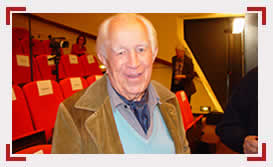skip to main |
skip to sidebar
David Douglas Duncan
David Douglas Duncan (born January 23, 1916) is an American photojournalist and among the most influential photographers of the 20th century. He is best known for his dramatic combat photographs.
Childhood and Education
Duncan was born in Kansas City, Missouri, where his childhood was marked with interest in the outdoors, which helped him obtain the rank of Eagle Scout in the Boy Scouts at a relatively young age. A lantern-slide presentation by big-game hunter and physician Richard L. Sutton, Sr., M.D. at Duncan's elementary school in Kansas City inspired an early interest in photography and world travel. Duncan briefly attended the University of Arizona, where he studied archaeology. While in Tucson, he inadvertently photographed John Dillinger trying to get into a hotel. Duncan eventually continued his education at the University of Miami, where he graduated in 1938, having studied zoology and Spanish. It was in Miami that his interest in photojournalism began in earnest. He worked as picture editor and photographer of the university paper.
Career
His career as a photojournalist had its origin when he took photographs of a hotel fire in Tucson, Arizona where he was then studying archaeology at the University of Arizona. His photos included one of a hotel guest who made repeated attempts to go back into the burning building for his suitcase. That photo proved to be newsworthy when the guest turned out to have been notorious bank robber John Dillinger and the suitcase to have contained the proceeds of a bank robbery in which he had shot a police officer. Unfortunately, after turning the film over to the Tucson Citizen, the film was lost forever, and the photos never printed.
After college, Duncan began to free lance, selling his work to journals such as The Kansas City Star, Life and the National Geographic Magazine. After Pearl Harbor Duncan joined the Marine Corps, earned an officer's commission, and became a combat photographer. After brief postings in California and Hawaii, he was sent to the South Pacific on assignment when the United States entered World War II. Though combat photographers are often close to the action, they rarely fight. However, in a brief engagement at Bougainville Island, Duncan found himself fighting against the Japanese. Duncan also covered the battle of Okinawa. Duncan would be on board the USS Missouri during the Japanese surrender.
His war time photographs were so impressive that, after the war, he was hired by Life to join their staff upon the urging of J.R. Eyerman, Life's chief photographer. During his time with Life he covered many events including the end of the British Raj in India and conflicts in Turkey, Eastern Europe, Africa and the Middle East.
Perhaps his most famous photographs were taken during the Korean War. He compiled many of his photos into a book called This Is War! (1951), with the proceeds going to widows and children of Marines who had been killed in the conflict. Duncan is considered to be the most prominent combat photographer of the Korean War.
In the Vietnam War, Duncan would eventually compile two additional books I Protest! (1968) and War Without Heroes (1970). Here, Duncan stepped out of his role as a neutral photographer and challenged how the US government was handling the war.
Aside from his combat photographs, Duncan is also known for his photographs of Pablo Picasso to whom he had been introduced by fellow photographer Robert Capa. Eventually, he was to publish seven books of photographs of Picasso. Duncan became a close friend of Picasso and was the only person allowed to photograph many of Picasso's private paintings. Duncan now lives in Valbonne, France, close to Mougins where Picasso spent his last 12 years.
Greatly assisting Nippon Kogaku (Nikon) during their early years, in 1965 Duncan was presented with the 200,00th Nikon F built in recognition for his use and popularization of their camera.
In 1966 he published Yankee Nomad a visual autobiography that collected representative photographs from throughout his career. In 2003 this was revised and published under the title of Photo Nomad.
Duncan traveled extensively in the Middle East, having been stationed there for 10 years as a Life photographer after World War Two. He later published The World of Allah in 1982.
Duncan holds the rank of Lieutenant Colonel, retired, in the United States Marine Corps Reserve. He is 96 years old and his memory is clear. He now makes his home in the South of France.
Books
- This Is War! (1951)
- The Private World of Pablo Picasso (1958)
- The Kremlin (1960)
- Picasso's Picassos (1961)
- Yankee Nomad (1966)
- I Protest! (1968)
- Self-Portrait: USA (1969)
- War Without Heroes (1970)
- Prismatics (1972)
- David Douglas Duncan [portfolio] (1972?)
- Goodbye Picasso (1974)
- The Silent Studio (1976)
- Magic Worlds of Fantasy (1978)
- The Fragile Miracle of Martin Gray (1979)
- Viva Picasso (1980)
- The World of Allah (1982)
- New York/New York (1984)
- Sunflowers for Van Gogh (1986)
- Picasso and Jacqueline (1988)
- A Secret Garden (1992)
- Thor (1993)
- Picasso Paints a Portrait (1996)
- Yo-Yo (1999)
- Faceless (2001)
- Photo Nomad (2003)
- Picasso & Lump (2006)





